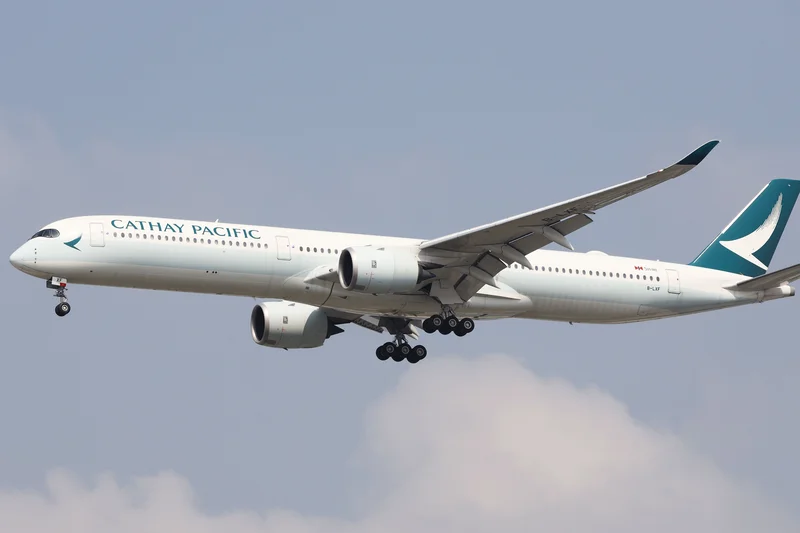So, Airbus and Cathay Pacific are joining hands to toss $70 million at the great, gaping maw of aviation’s carbon problem. Seventy. Million. Dollars. Let that sink in. For two corporate behemoths whose combined annual revenue is in the tens of billions, this is the equivalent of you and me chipping in to buy a single brick for a new skyscraper.
It’s a rounding error. A budget line item filed under "Marketing: Green-Flavored."
They announced Cathay Group & Airbus Invest $70M To Accelerate SAF Adoption at the IATA World Sustainability Symposium in Hong Kong, because of course they did. You have to announce these things in a room full of suits, under flattering lights, where the applause can drown out the sound of the planet quietly screaming. It’s all part of the theater. And make no mistake, this is pure theater.
The Super Soaker and the Forest Fire
Let’s be brutally honest about what this money is for. The press release is a masterclass in corporate vaguery, promising to "identify, evaluate and invest" in projects. Translation: they’re forming a committee. They’re going to spend the next few years paying consultants to write reports about reports, all while Sustainable Aviation Fuel (SAF) continues to account for less than 1% of the jet fuel actually being burned.
This $70 million partnership is like showing up to a five-alarm forest fire with a Super Soaker. It makes for a great photo op—look, we’re helping!—but the fire doesn't even notice your presence. The scale of the problem is so vast, so existentially terrifying, that this "investment" feels less like a solution and more like an insult to our intelligence.
Anand Stanley, the Airbus President for Asia-Pacific, said this "reflects the shared commitment of Airbus and Cathay to make a real difference." Let me translate that for you: "This press release reflects our shared commitment to looking like we’re making a real difference while we continue business as usual." What real difference can $70 million possibly make when the industry needs hundreds of billions to even begin to scale SAF production to a meaningful level? When SAF itself costs up to five times more than the fossil-guzzling jet-A it’s meant to replace?
These aren't serious questions, because this isn't a serious proposal. It’s a performance.
The Shell Game of "Sustainability"
This whole SAF push is the airline industry's favorite magic trick. They wave it in our faces, a shimmering vial of green goo, to distract us from the uncomfortable truth: the only real way to reduce aviation emissions right now is to fly less. And that’s the one thing they will never, ever admit.

So instead, we get this shell game. Cathay is already an investor in the oneworld alliance’s BEV SAF Fund, which is for "breakthrough" tech. This new Airbus fund is for "mature" tech. See the strategy? They're placing tiny bets on every square of the roulette table so that no matter where the ball lands, they can claim they had a winning number. It's not a decarbonization strategy; it's a portfolio diversification strategy for their PR department.
The timing is just perfect, too. Cathay is busy patting itself on the back for finally relaunching its nonstop service from Seattle to Hong Kong. Isn't that wonderful? More flights, more connections, more opportunities to burn thousands of tons of kerosene hurtling across the Pacific. It's like an oil company sponsoring a "Bike to Work" week. The cognitive dissonance is staggering.
I’m being too cynical. No, 'cynical' doesn't cover it—I’m being a realist. The facts are the facts. SAF production in 2025 is projected to be a pathetic 0.7% of the industry’s needs. This investment won’t move the needle. It can’t.
So What's the Real Play Here?
If this isn't about saving the planet, then what is it about? Money, offcourse. It always is.
For Cathay, this is a hedge. By getting in on the ground floor of a few SAF projects, they can potentially lock in future supply at a slightly less extortionate price. It gives them something to sell to their corporate clients who are desperate to check the "sustainable travel" box on their expense reports. It’s an insurance policy against future carbon taxes and blending mandates that they know are coming. It’s a financial instrument, not an environmental one.
For Airbus, it’s about protecting their core business: selling airplanes. They can't sell multi-hundred-million-dollar jets if regulations make it impossible for airlines to fly them affordably. So, they have to be seen as a proactive part of the solution. By co-investing, they strengthen their relationship with a major customer and create a "repeatable model" to lure other airlines into similar deals. It’s a brilliant piece of long-term salesmanship, ensuring their A350s keep rolling off the assembly line.
They’re both just trying to secure their own futures in a world that is slowly, painfully waking up to the fact that the party's over. And honestly… they’ll probably get away with it. We’ll all read the headlines, nod approvingly, and book our next flight.
The Green Paint Is Still Wet
Let's call this what it is: a beautifully executed piece of corporate public relations. It's not a solution. It's not even a meaningful step toward a solution. It's a calculated, low-cost investment designed to generate positive headlines and buy political goodwill. It’s a fresh coat of green paint on a machine that will continue, for the foreseeable future, to pump carbon into the only atmosphere we have. The real problem isn't the fuel; it's the business model that demands infinite growth on a finite planet. And that's the one conversation this $70 million is designed to help everyone avoid.
